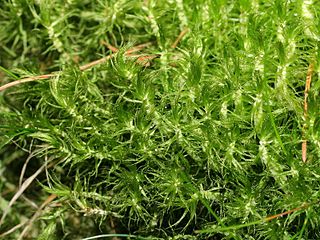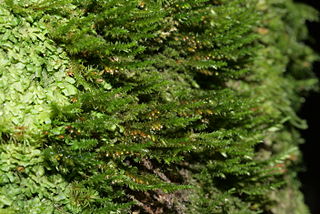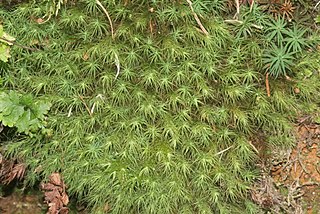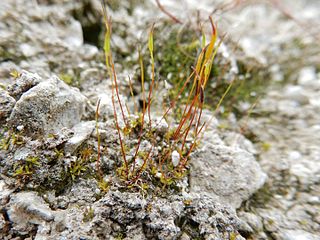
Dicranum is a genus of mosses, also called wind-blown mosses or fork mosses. These mosses form in densely packed clumps. Stems may fork, but do not branch. In general, upright stems will be single but packed together. Dicranum is distributed globally. In North America these are commonly found in Jack pine or Red pine stands.

Hypnaceae is a large family of moss with broad worldwide occurrence in the class Bryopsida, subclass Bryidae and order Hypnales. Genera include Hypnum, Phyllodon, and Taxiphyllum.

Cryphaea is a genus of mosses, (Bryophyta), containing at least 26 accepted species.

Bartramiales is an order of moss.

Aulacomnium is a genus of mosses of the family Aulacomniaceae, with a circumpolar distribution.

Plagiomnium is a genus of mosses in the family Mniaceae. It was formerly a part of a more encompassing genus Mnium and in 1968 Finish bryologist Timo Juhani Koponen justified splitting the genus into a number of smaller genera.

Distichium is a genus of haplolepideous mosses (Dicranidae) in the monotypic family Distichiaceae.
Alleniella is a genus of mosses belonging to the family Neckeraceae.

Aloina is a genus of mosses belonging to the family Pottiaceae first described by Nils Conrad Kindberg. It has a cosmopolitan distribution.

Rhynchostegium is a genus of pleurocarpous mosses belonging to the family Brachytheciaceae. The genus has a cosmopolitan distribution across different climatological regions except the polar regions, mostly in tropic to north temperate regions. The genus contains both aquatic and terrestrial species. The genus was named for their rostrate opercula. The type species of this genus is Rhynchostegium confertum (Dicks.) Schimp.
Amblyodon is a genus of mosses belonging to the family Meesiaceae.

Homalothecium is a genus of mosses belonging to the family Brachytheciaceae.

Tetraplodon is a genus of mosses belonging to the family Splachnaceae.

Rhizogonium is a genus of mosses belonging to the family Rhizogoniaceae.
Pylaisia is a genus of mosses belonging to the family Pylaisiaceae.

Ptychostomum is a genus of mosses belonging to the family Bryaceae. It has an almost cosmopolitan distribution.

Mnium is a genus of mosses belonging to the family Mniaceae. The species of this genus are found in Europe and North America.
Bartramiaceae is a family of mosses belonging to the order Bartramiales.
Leskeaceae is a family of mosses belonging to the order Hypnales.













